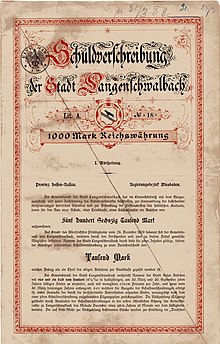
The Taunus is a mountain range in Hesse, Germany, located north of Frankfurt. The tallest peak in the range is Großer Feldberg at 878 m; other notable peaks are Kleiner Feldberg and Altkönig.
Rheingau-Taunus is a Kreis (district) in the west of Hesse, Germany. Rheingau-Taunus-Kreis is part of the Darmstadt region; its main administrative seat is Bad Schwalbach. Outposted sections of the local administration are located in Idstein and Rüdesheim am Rhein.
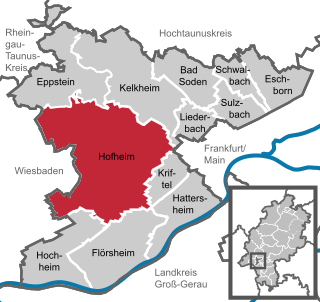
Hofheim is the administrative centre of Main-Taunus-Kreis district, in the south of the German state of Hesse. Its population in September 2020 was 39,946.

Kronberg im Taunus is a town in the Hochtaunuskreis district, Hesse, Germany and part of the Frankfurt Rhein-Main urban area. Before 1866, it was in the Duchy of Nassau; in that year the whole Duchy was absorbed into Prussia. Kronberg lies at the foot of the Taunus, flanked in the north and southwest by forests. A mineral water spring also rises in the town.
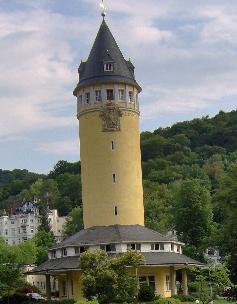
Bad Ems is a town in Rheinland Pfalz, Germany. It is the administrative seat of the Rhein-Lahn rural district and is well known as a spa on the river Lahn. Bad Ems is the seat of the Verbandsgemeinde Bad Ems-Nassau. The town has around 9,000 inhabitants.
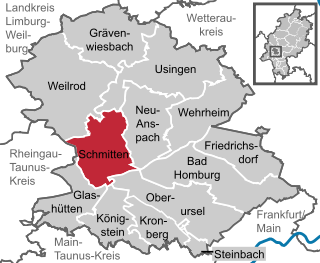
Schmitten im Taunus is a municipality in the Hochtaunuskreis in Hessen, Germany.

Königstein im Taunus is a health spa and lies on the thickly wooded slopes of the Taunus in Hesse, Germany. The town is part of the Frankfurt Rhein-Main urban area. Owing to its advantageous location for both scenery and transport on the edge of the Frankfurt Rhine Main Region, Königstein is a favourite residential town. Neighbouring places are Kronberg im Taunus, Glashütten, Schwalbach am Taunus, Bad Soden am Taunus and Kelkheim.

Schlangenbad is a municipality in the Rheingau-Taunus-Kreis in the Regierungsbezirk of Darmstadt in Hesse, Germany.

Taunusstein is the biggest town in the Rheingau-Taunus-Kreis in the Regierungsbezirk of Darmstadt in Hessen, Germany. It has 30,068 inhabitants (2020).

Sontra is a small town in the Werra-Meißner-Kreis in northeastern Hesse, Germany.

Wiesbaden Hauptbahnhof is a railway station for the city of Wiesbaden, the state capital of the German state of Hesse. It is a terminal station at the southern edge of the city centre and is used by more than 40,000 travelers each day, so it is the second largest station in Hesse after Frankfurt Hauptbahnhof. It is classified by Deutsche Bahn as a category 2 station.
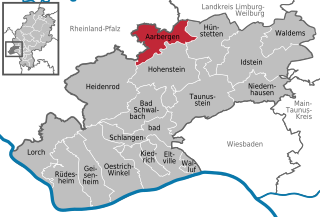
Aarbergen is a municipality in the Rheingau-Taunus-Kreis in the Regierungsbezirk of Darmstadt in Hesse, Germany.

Heidenrod is a municipality in the Rheingau-Taunus-Kreis in the Regierungsbezirk of Darmstadt in Hesse, Germany. Seat of municipal administration is to be found in the most populated municipal district, in Laufenselden.

The Aar is a 50-kilometre-long (31 mi) river in western Germany, left tributary of the Lahn. It rises in the Taunus mountains, near Taunusstein. It flows generally north through the towns Taunusstein, Bad Schwalbach, Aarbergen and Hahnstätten. It flows into the Lahn in Diez.
William I "the Elder" of Hesse-Rotenburg was from 1683 until his death Landgrave of Hesse-Rotenburg. He was a son of Ernest I of Hesse-Rotenburg-Rheinfels and his wife, Countess Maria Eleonore of Solms-Lich. William was nicknamed the Elder to distinguish him from his nephew, William of Hesse-Wanfried.

Niedernhausen station serves the municipality of Niedernhausen in the German state of Hesse. It is the most important station on the Main-Lahn Railway between the stations of Frankfurt-Höchst and Eschhofen in Limburg an der Lahn. It is the terminus of the Ländches Railway running from Niedernhausen to Wiesbaden Hauptbahnhof and of line S2 of the Rhine-Main S-Bahn from Frankfurt.

Bad Soden (Taunus) station is the northern terminus of the Soden Railway in the German state of Hesse. It is also the northern terminus of line S3 of the Rhine-Main S-Bahn over the Limes Railway (Limesbahn).
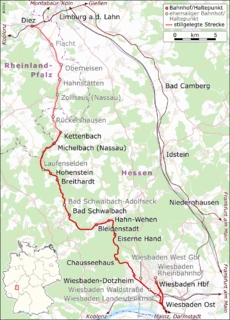
The Aar Valley Railway is a 53.7 km long line between Wiesbaden, the capital of the German state of Hesse, and Diez in Rhineland-Palatinate. From 1985 to 2007, the southern end was operated as a heritage railway with historic trains. The Hessian part of the line is heritage-listed. Currently, two bridges are unusable and several sets of points are defective and need to be repaired. Its northern end is operated with draisines.
The village of Ramchied is a district of the town of Bad Schwalbach in the Rheingau-Taunus-Kreis region of the state of Hessen, Germany. It is also referred to as Bad Schwalbach - Ramschied.









